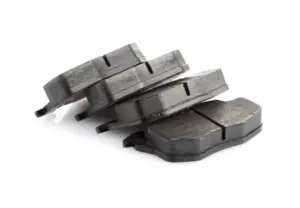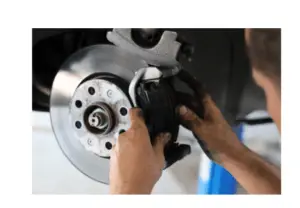Brake pads are an integral part of a vehicle’s brake system. They provide the friction necessary to slow down or stop your vehicle when pressure is applied to the brake pedal. Comprised of heat-resistant materials, brake pads grip onto the brake disc (also known as brake rotors) to create the resistance needed to decelerate.
They play a crucial role in ensuring that your vehicle can stop safely and effectively, which makes understanding them important for every driver and vehicle owner.
We will dig into the specifics of brake pad configuration, explaining how many brake pads per wheel in a standard disc brake system. We’ll explore the role and types of brake pads, their setup in different braking systems, and the signs that indicate they may need replacement.
We’ll also address some frequently asked questions about how many brake pads per wheel, aiming to provide a comprehensive understanding of this critical component of your vehicle’s brake system.
Contents
- 1 Understanding Brake Pads
- 2 Brake Pad Configuration
- 3 Brake Pads in Different Types of Brakes
- 4 How to Know When to Replace Brake Pads
- 4.1 Frequently Asked Questions
- 4.1.1 Can I replace just one brake pad at a time?
- 4.1.2 Are all brake pads the same size?
- 4.1.3 How long do brake pads last?
- 4.1.4 How many brake pads PER Wheel are there on a vehicle?
- 4.1.5 Do all brake pads wear out at the same rate?
- 4.1.6 Should I replace all brake pads at once?
- 4.1.7 How often do brake pads need to be replaced?
- 4.1.8 What are the signs that my brake pads need replacing?
- 4.2 Conclusion
- 4.1 Frequently Asked Questions
Understanding Brake Pads

As part of the braking system, brake pads are essential for bringing your vehicle to a halt. When you press the brake pedal, hydraulic pressure is transmitted through the brake fluid in the system to the brake caliper.
This causes the brake pads, which are housed in the calipers, to clamp down onto the rotating brake rotors. The resulting friction slows down the rotation of the wheel, allowing the vehicle to decelerate or come to a complete stop.
There are several different types of brake pads, which vary according to the materials used in their construction and the type of vehicle they are designed for. Some common types include semi-metallic, organic, and ceramic brake pads.
Semi-metallic pads are durable and offer excellent heat dissipation, making them a popular choice for many vehicles.
Organic pads, made from non-metallic fibers, are quieter and produce less wear on the brake rotors but tend to wear out faster than their semi-metallic counterparts.
Ceramic pads, while often more expensive, are durable, quiet, and produce less dust, making them a popular choice for high-end vehicles and those in heavy braking conditions.
Brake Pad Configuration
In a typical disc brake system, there are two brake pads per wheel answers the question of how many brake pads per wheel. The brake rotor (disc) sits between these two pads. When you apply the brakes, hydraulic pressure forces these brake pads to work together against either side of the rotor, creating the friction necessary to slow or stop the wheel’s rotation. The brake caliper houses these pads and facilitates this pressing action.
Both front and rear wheels typically employ the same basic configuration of two brake pads per wheel. However, in many vehicles, the front brakes do more of the work due to weight transfer during braking. As a result, front brake pads may be larger or made from different materials to handle the increased heat and friction.
Some vehicles, especially older models, might use disc brakes in the front for their superior stopping power and drum brakes in the rear brakes, which have different components and operations but serve the same fundamental purpose of braking force.
Brake Pads in Different Types of Brakes
As discussed, disc brake systems feature two brake pads per wheel. These pads, located on either side of the rotor within the caliper, provide the friction necessary for slowing and stopping the vehicle.
They are typically made of a durable friction material that can withstand the high temperatures generated during braking. Over time, these pads wear down and must be replaced to ensure effective and safe braking.
Unlike disc brakes, drum brake systems do not use brake ‘pads.’ Instead, they utilize brake ‘shoes.’ In a drum brake setup, there are typically two brake shoes per wheel. These shoes press outward against the inside of a brake drum to create friction and slow the vehicle with the rear brakes.
While they serve a similar function as disc brake pads, their wear patterns, performance characteristics, and replacement procedures can be quite different.
Therefore, understanding the type of braking system in your vehicle is crucial for proper maintenance, safe operation, consistent braking performance, and optimal braking performance.
If your vehicle has 4-wheel disc brakes then it would use eight brake pads for four wheels. If your car only has front disc brakes then it would have four brake pads.
How to Know When to Replace Brake Pads

Various signs indicate that brake pads may be wearing out. Some of these include a squealing or squeaking noise when brakes are applied, a grinding sound indicating that the pad’s friction material is completely worn down, reduced responsiveness when braking, or a vibrating brake pedal.
Another clear sign is the brake warning light illuminating your vehicle’s dashboard.
Regular brake pad maintenance is critical for vehicle safety. Neglecting this can lead to reduced braking effectiveness, which might cause accidents. Furthermore, worn-out disc brakes can damage other components of the braking system, such as the rotors and calipers, leading to more expensive repairs.
Generally, disc brakes should be inspected regularly (every 10,000 to 20,000 miles) and replaced when they reach a certain thickness — typically around 1/4 inch. However, the specific maintenance schedule for brake pad replacement can depend on the vehicle, driving conditions, and brake pad material.
Frequently Asked Questions
Can I replace just one brake pad at a time?
While it’s technically possible to replace only one brake pad, it’s not recommended for safety reasons. Brake pads should always be replaced in pairs (both front and both rear pads) to ensure even braking. If you replace just one pad, it could result in uneven braking, which might make the vehicle unstable, particularly in emergency situations.
Are all brake pads the same size?
No, brake pads are not all the same size. The size and type of brake pad required will depend on the vehicle’s make, model, and braking system. Always ensure you have the correct pads for your specific vehicle to guarantee proper performance and safety.
How long do brake pads last?
The lifespan of brake pads varies depending on several factors, including driving habits, environment, and the type of brake pads used. On average, brake pads should last between 30,000 to 70,000 miles. However, they should be inspected regularly to ensure they’re still functioning properly and replaced as needed.
How many brake pads PER Wheel are there on a vehicle?
In a typical car braking system, there are generally two brake pads per wheel, one each on the inner and outer sides of the brake rotor or disc. When you apply the brakes, hydraulic pressure causes these pads to squeeze against the rotor, creating the friction necessary to slow or stop the vehicle.
Do all brake pads wear out at the same rate?
Not necessarily. The rate at which brake pads wear can depend on several factors, such as driving style, driving conditions, and the type of brake pads used. For example, the front brake pads often wear faster than the rear ones because they handle more of the braking load in most vehicles.
Should I replace all brake pads at once?
It’s generally recommended to replace brake pads in pairs, i.e., both pads on the same axle (either both front pads or rear brake pads) at the same time. This helps ensure balanced braking. If one new pad is paired with an old, worn one, it could cause the vehicle to pull to one side when braking.
How often do brake pads need to be replaced?
The lifespan of brake pads can vary widely depending on the factors mentioned earlier. However, on average, brake pads may need to be replaced approximately every 50,000 miles. It’s important to have your brakes checked regularly and listen for any unusual sounds, such as squeaking or grinding, which could indicate that the pads are worn and need to be replaced.
What are the signs that my brake pads need replacing?
Signs that your car’s brake pads may need replacing include a squeaking or squealing noise when braking, a grinding noise (which may indicate that the pads are worn down to the metal), reduced brake performance, a vibrating brake pedal, or the vehicle pulling to one side when braking. Some vehicles also have a brake warning light on the dashboard that illuminates when the pads are worn.
Conclusion
To recap, we’ve learned that the number of how many brake pads per wheel typically depends on the type of braking system used. In disc brake systems, each wheel has two brake pads, while drum brakes don’t use pads but have brake shoes instead. We also discovered that maintaining and replacing these components when necessary is crucial to the overall safety and efficiency of your vehicle’s braking system when you have worn brake pads.
Knowing the ins and outs of your vehicle’s brake system, including the configuration and purpose of brake pads, allows for more informed decisions regarding maintenance and troubleshooting. It helps ensure that you’re aware of potential issues before they become more serious problems, enhancing the longevity and performance of your vehicle.
Ultimately, regular inspection and maintenance of your vehicle’s disc brakes is a matter of safety – for you, your passengers, and others on the road. It’s always best to seek the advice of a professional mechanic if you’re uncertain about replacing brake pads. Don’t let minor brake maintenance issues become major ones; maintain your vehicle regularly, and it will serve you well.
